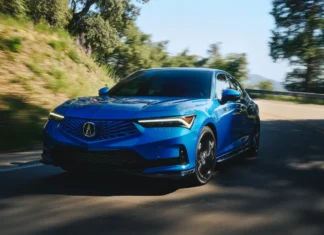
Gas prices skyrocketed in the past week, to an average of $4.10 per gallon.
The world has changed dramatically in the past few weeks, let alone the two-year period in which I’d normally frame this story in light of the COVID-19 pandemic. Nationwide, U.S. consumers are facing gas prices over $4 per gallon for the first time in more than a decade, and there’s currently not an end in sight for the recent and dramatic surge. Sites like Gasbuddy.com and the AAA’s price tracker can help you keep an eye on the current situation.

In light of this major jump, we wanted to cover the most fuel efficient vehicles out there if you’re in the market. We’ll have a series of “TFL on Empty” videos over the coming week, in which we’ll cover the best options if you’re looking for the most mileage out of your next new vehicle.
Before we get into it, though, a couple sidebars. The first: Inventory levels are still tight as the global economy works its way clear of pandemic-related shortages, including semiconductors. On that basis, you still may have to contend with low availability (and possibly dealer markups) — especially if there’s a rush for more efficient vehicles a la 2008. The other hits closer to the human element, and that is Russia’s war against Ukraine, which analysts and outlets are blaming the upending of global oil prices.
Here at TFL Studios, or general policy is to be a place to get away from fractious issues — and as such we’ve made it a matter of course to keep with automotive topics. Whether you agree with that stance or not, that’s what we will continue to do here, though it’s also important for accuracy in reporting to address the context around these higher gas prices.

The 5 most fuel efficient (non-plug-in) cars
With gas prices heading skyward once again — average figures are up roughly $1.30 from this point last year — you may want to take a look at the most fuel efficient cars currently on the market. Even if you’re not ready to make the jump toward a full EV, today’s hybrids can still pack over 50 MPG. Beyond sheer efficiency, they usually aren’t massively expensive to buy either. Sure, they may not be the utmost exciting cars to drive, but if you want to avoid some serious strain on your wallet, consider one of these models:
- 5. Honda Insight (52 MPG combined; starting MSRP $26,775)
- 4. Hyundai Elantra Hybrid Blue* (54 MPG combined; starting MSRP $24,895)
- The base ‘Blue’ is the most efficient, while the Limited manages 50 MPG combined.
- 3. Hyundai Ioniq Hybrid SE/SEL/Limited* (55 MPG combined; starting MSRP $26,565)
- It’s the same story with the Ioniq. Fuel economy on the non-Blue models decrease to 55 MPG combined.
- 2. Toyota Prius L Eco (55 MPG combined; starting MSRP $25,650)
- 1. Hyundai Ioniq Blue* (59 MPG combined; starting MSRP $24,465)
These are the most efficient non-plug-in hybrid cars according to official EPA figures. The Ioniq and Elantra are within a few hundred dollars of each other, though I’d lean toward the more practical Ioniq if I were choosing between the two. The Prius, as ever, is near the pinnacle of fuel efficiency as you’d expect, while the current Honda Insight also offers a solid option for fuel-thrifty buyers.

TFL’s Top 5 recommendations
But what if the technically most fuel efficient cars don’t appeal? We’ve also narrowed down the five hybrids or plug-in hybrids we’d shoot for. These cars balance practicality with efficiency thanks to their larger size (and in some cases, all-wheel-drive). Fuel economy here is still respectable — over 35 MPG in most cases:
- 5. Kia Sorento Hybrid (32 MPG combined; MSRP $35,305)
- 4. Ford Escape Hybrid (40 MPG combined; MSRP $30,415)
- 3. Toyota Sienna AWD (35 MPG combined; MSRP $38,000)
- 2. Honda CR-V Hybrid (38 MPG combined; MSRP $32,835)
- 1. Toyota RAV4 Prime (42 miles EV range/38 MPG combined; MSRP $41,015)
Now, in the Kia Sorento and Ford Escape’s cases, you can step into a plug-in hybrid if you want to. However, the conventional hybrid versions of both cars are substantially cheaper. If you’re looking at the Escape, you can also get the Hybrid with all-wheel-drive (the Escape PHEV is front-wheel-drive only). As for the Sorento, you’ll spend roughly $10,000 more to get into the PHEV versus the regular (and still efficient) Sorento Hybrid.
While all these cars are still efficient, the Toyota RAV4 Prime offers the most power of this bunch, by far. 302 horsepower combined is what it puts out, not to mention it offers up to 42 miles of pure-electric driving range. The down side? It is expensive — especially in the current market. If you get the XSE model rather than the base SE or come up against a dealer marking the Prime up because of small inventory numbers, expect to pay around $50,000 for the privilege of owning one.























